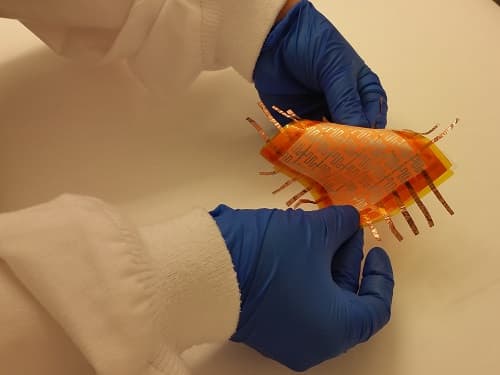Paper Based Sensor That Emulates Human Skin
A group of electrical engineers from the King Abdullah University of Science and Technology in Saudi Arabia has designed a sensor circuitry that can imitate the functions of the human skin. With the help of Kitchen tools, the team presented a novel approach to create such a light weight paper based cost effective design that delivers quality performance.
Named as “Paper Skinâ€, it works well even when compared to artificial skins used for AI based systems. Muhammad Mustafa Hussain from the University’s Integrated Nanotechnology Lab explained that their work is capable of bringing in a revolution in the high-end electronics sector and eventually lead to subsidization of the sensor based systems as a whole. The team developed their research product using cheap sub parts, among which the sticky note paper detects humidity, sponges and wipes detect pressure and aluminium foils detect motion. A HB pencil colour sticky note helped to detect acidity level whereas on the other side, the aluminium foil and conductive silver accurately predicted the temperature differences.

The flexible temperature array
Recycling and reusing the available tools managed to produce an output which is flexible enough to emerge as a key product for contemporary wearable devices. Collectively, the materials were incorporated in a paper based platform which was connected to an electrical detector that measures the change in electrical conductivity due to external factors such as touch, pressure, temperature, acidity and humidity. Thus, scientists were able to control the physical parameters as and when required. For example, increasing levels of humidity increased the platform’s ability to store electrical charge or capacitance. On the other side, exposing the sensor to an acidic solution increased the resistance.
Hussain asserted that the system needs some modifications before being officially launched into the market. The nascent project however possesses the potential to initiate a technological breakthrough if applied in correct way. A probable use of this device can be observed in wireless monitoring of the patients’ health and in a touch-free computer interface system. The paper was titled as “skin multi-sensory platform for simultaneous environmental monitoring†and published in the Advanced Materials Technologies journal.
Source: Artificial skin sensors made from sticky notes | KAUST Discovery
Named as “Paper Skinâ€, it works well even when compared to artificial skins used for AI based systems. Muhammad Mustafa Hussain from the University’s Integrated Nanotechnology Lab explained that their work is capable of bringing in a revolution in the high-end electronics sector and eventually lead to subsidization of the sensor based systems as a whole. The team developed their research product using cheap sub parts, among which the sticky note paper detects humidity, sponges and wipes detect pressure and aluminium foils detect motion. A HB pencil colour sticky note helped to detect acidity level whereas on the other side, the aluminium foil and conductive silver accurately predicted the temperature differences.

The flexible temperature array
Hussain asserted that the system needs some modifications before being officially launched into the market. The nascent project however possesses the potential to initiate a technological breakthrough if applied in correct way. A probable use of this device can be observed in wireless monitoring of the patients’ health and in a touch-free computer interface system. The paper was titled as “skin multi-sensory platform for simultaneous environmental monitoring†and published in the Advanced Materials Technologies journal.
Source: Artificial skin sensors made from sticky notes | KAUST Discovery
Replies
You are reading an archived discussion.
Related Posts
A team of chemists and engineers from the University of Texas, Arlington have finally come up with a one step process to directly convert Carbon dioxide and water into liquid...
CAN U PLEASE GIVE INFORMATION ABOUT THE COMPANIES WHICH OFFERING IN PLANT TRAINING IN MECHANICAL AND ROBOTICS STREAM?
Hey CE,
I want to build (or buy, if it already exists) a cable winch with programmable attraction. I need a max. attraction of 300 kg (about 650 pounds).
I...
Dear friends,
I am an electrical and electronics engineer with an aggregate of 64%. I am graduated in July 2015. Still I cannot get job.
Which job oriented course is...
